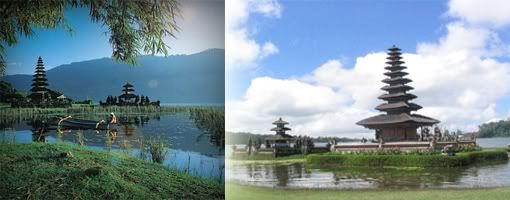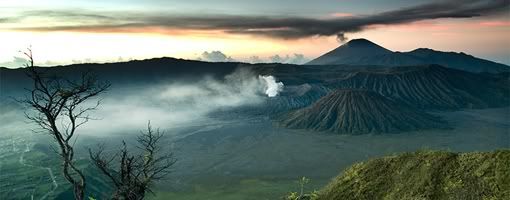
Ijen Plateau- Home-Grown Sulfur
Ijen plateau or known as "Kawah Ijen" is highly recommended to mountain buffs and hikers. The Plateau was at one time a huge active crater, 134 sq km in area. Today, Ijen is a quiet but active volcano, and the landscape is dominated by the volcanic cones of Ijen (2,368 asl) and Merapi (2,800 asl) on the northeastern edge of the Plateau, and Raung (3,332 asl) on the southwest corner.
The magnificent turquoise sulfur lake of Kawah Ijen lies at 2148 m above sea level and is surrounded by the volcanos sheer crater walls. The vent is a source of sulfur and collectors work here, making the trek up to the crater and down to the lake every day. Sulfur collectors hike up in the morning and return around 1 pm when the clouds roll in. They carry shoulder basket of pure sulfur from a quarry on the lakes edge under the shadow of the sheer walls of the crater. The mineral at Kawah Ijen is purer and is worth commercial exploitation despite the horrendous labor involved: Javas homegrown sulfur is a natural source of sulfuric acid, in great demand in the oil-refining business and in the production of fertilizers.
Getting There
The Ijen Plateau can be reached through Bondowoso from either the northern or the southern coast. It is closer to Banyuwangi, but the road is very steep and badly deteriorated. A 4 WD is essential, although difficult to hire in Banyuwangi and outrageously expensive. Most people walk the last 8 km along the road to Pos Paltuding (the PHPA Post, the starting point or the trek to the crater).
Where to Stay
You can choose your places of stay at Bondowoso or Banyuwangi. There's a few type of accommodation with varied price and facilities.
Moving Around
You can take a walk for about 1-1 1/2 hour to the crater rim.
Dining Guide
Before start trekking, hiking or climbing, be sure that you have already eaten, or you can bring some food and drink from your places.of stay. Otherwise, you can buy some food and non alcoholic drink on the nearest supermarkets for your supply during your activities on mountain.
Souvenir Tips
The sulphur diggers will approach you for playing a guide and sell some nice sulphur statues for 5.000 till 10.000 Rp (probably their day-income).
Other Things to See or Do
At the rim itself you have a nice view on the lake. You can walk around the rim or go immediately left so you can walk down to the lake for about 40 minutes.
Travel Tips
*
The walk starts at Pal Tuding. Its a basic camp where you can stay overnight. There is a block with showers and toilets
*
At night it can be pretty cold up there,(it is suggested that you carry a sleeping bag). Take your own picnic, since the food you can buy at the parking lot isn't up to much.
*
The walk up to the crater rim takes 60-90 minutes. It's pretty steep. Halfway is a small post where the sulphurworkers take a break. A cup of tea is available here.
*
The path is just one-way so there is no need for any guidance.
*
An absolute must is a handkerchief to put in front of your mouth and nose to avoid inhalation of the sulphur gases.
*
If you buy some souvenirs like statues, they are very breakable so tape them in with toilet paper and take precious care of it.








